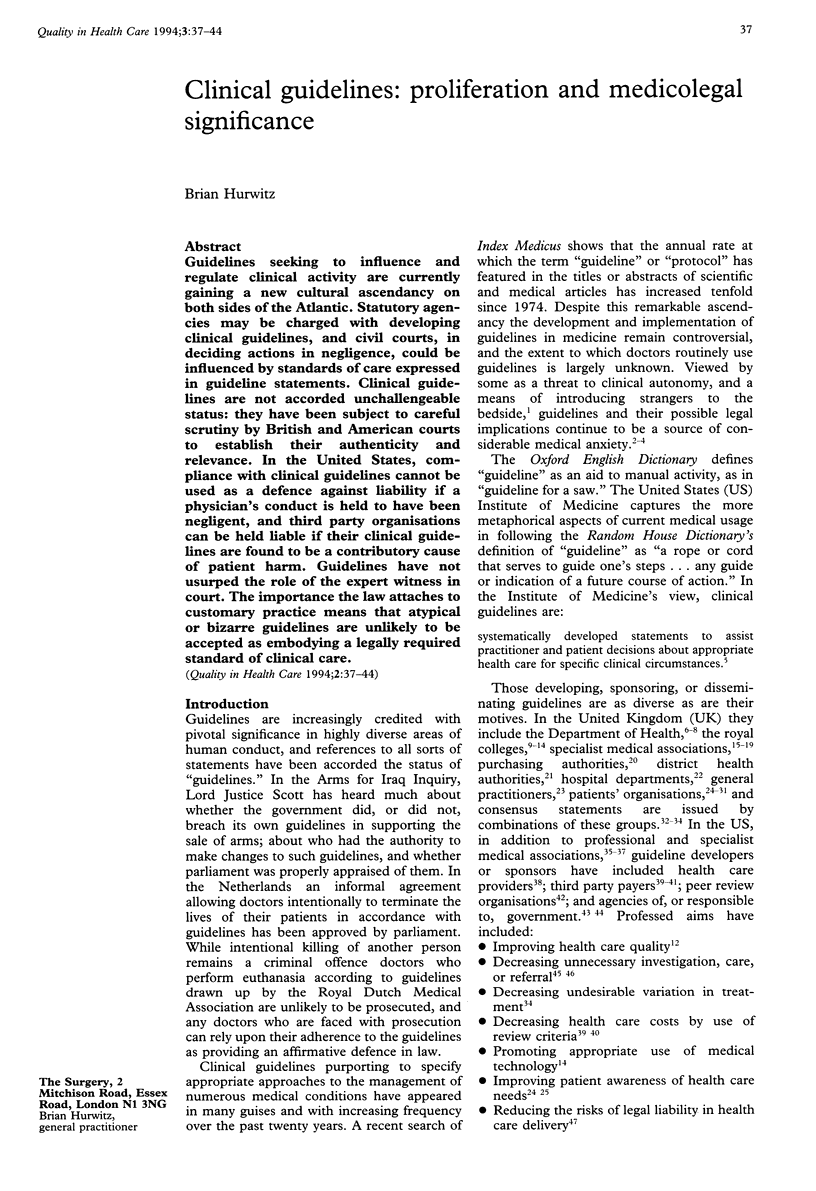Abstract
Guidelines seeking to influence and regulate clinical activity are currently gaining a new cultural ascendancy on both sides of the Atlantic. Statutory agencies may be charged with developing clinical guidelines, and civil courts, in deciding actions in negligence, could be influenced by standards of care expressed in guideline statements. Clinical guidelines are not accorded unchallengeable status: they have been subject to careful scrutiny by British and American courts to establish their authenticity and relevance. In the United States, compliance with clinical guidelines cannot be used as a defence against liability if a physician's conduct is held to have been negligent, and third party organisations can be held liable if their clinical guidelines are found to be a contributory cause of patient harm. Guidelines have not usurped the role of the expert witness in court. The importance the law attaches to customary practice means that atypical or bizarre guidelines are unlikely to be accepted as embodying a legally required standard of clinical care.
Full text
PDF







Selected References
These references are in PubMed. This may not be the complete list of references from this article.
- Coll J. Interview with Joaquim Coll. What is going to happen tomorrow as far as secondary Sjögren's syndrome is concerned?. Interview by P. Youinou. Ann Med Interne (Paris) 1993;144(4):257–259. [PubMed] [Google Scholar]
- Crombie D. L., Fleming D. M. General practitioner referrals to hospital: the financial implications of variability. Health Trends. 1988 May;20(2):53–56. [PubMed] [Google Scholar]
- Delamothe T. Wanted: guidelines that doctors will follow. BMJ. 1993 Jul 24;307(6898):218–218. doi: 10.1136/bmj.307.6898.218. [DOI] [PMC free article] [PubMed] [Google Scholar]
- Eddy D. M. Clinical decision making: from theory to practice. Designing a practice policy. Standards, guidelines, and options. JAMA. 1990 Jun 13;263(22):3077–3084. doi: 10.1001/jama.263.22.3077. [DOI] [PubMed] [Google Scholar]
- Eichhorn J. H., Cooper J. B., Cullen D. J., Maier W. R., Philip J. H., Seeman R. G. Standards for patient monitoring during anesthesia at Harvard Medical School. JAMA. 1986 Aug 22;256(8):1017–1020. [PubMed] [Google Scholar]
- Ellwood P. M. Shattuck lecture--outcomes management. A technology of patient experience. N Engl J Med. 1988 Jun 9;318(23):1549–1556. doi: 10.1056/NEJM198806093182327. [DOI] [PubMed] [Google Scholar]
- Farmer A. Medical practice guidelines: lessons from the United States. BMJ. 1993 Jul 31;307(6899):313–317. doi: 10.1136/bmj.307.6899.313. [DOI] [PMC free article] [PubMed] [Google Scholar]
- Fink A., Kosecoff J., Chassin M., Brook R. H. Consensus methods: characteristics and guidelines for use. Am J Public Health. 1984 Sep;74(9):979–983. doi: 10.2105/ajph.74.9.979. [DOI] [PMC free article] [PubMed] [Google Scholar]
- Gonzalez M. E., Pardo-Manuel de Villena F., Fernandez-Ruiz E., Rodriguez de Cordoba S., Lazo P. A. The human CD53 gene, coding for a four transmembrane domain protein, maps to chromosomal region 1p13. Genomics. 1993 Dec;18(3):725–728. doi: 10.1016/s0888-7543(05)80385-4. [DOI] [PubMed] [Google Scholar]
- Gottlieb L. K., Margolis C. Z., Schoenbaum S. C. Clinical practice guidelines at an HMO: development and implementation in a quality improvement model. QRB Qual Rev Bull. 1990 Feb;16(2):80–86. doi: 10.1016/s0097-5990(16)30343-8. [DOI] [PubMed] [Google Scholar]
- Grimshaw J. M., Russell I. T. Achieving health gain through clinical guidelines II: Ensuring guidelines change medical practice. Qual Health Care. 1994 Mar;3(1):45–52. doi: 10.1136/qshc.3.1.45. [DOI] [PMC free article] [PubMed] [Google Scholar]
- Grimshaw J. M., Russell I. T. Effect of clinical guidelines on medical practice: a systematic review of rigorous evaluations. Lancet. 1993 Nov 27;342(8883):1317–1322. doi: 10.1016/0140-6736(93)92244-n. [DOI] [PubMed] [Google Scholar]
- Harvey I. M., Roberts C. J. Clinical guidelines, medical litigation, and the current medical defence system. Lancet. 1987 Jan 17;1(8525):145–147. doi: 10.1016/s0140-6736(87)91976-3. [DOI] [PubMed] [Google Scholar]
- Kellie S. E., Kelly J. T. Medicare Peer Review Organization preprocedure review criteria. An analysis of criteria for three procedures. JAMA. 1991 Mar 13;265(10):1265–1270. [PubMed] [Google Scholar]
- Mehlman M. J. Assuring the quality of medical care: the impact of outcome measurement and practice standards. Law Med Health Care. 1990 Winter;18(4):368–384. doi: 10.1111/j.1748-720x.1990.tb01153.x. [DOI] [PubMed] [Google Scholar]
- Sever P., Beevers G., Bulpitt C., Lever A., Ramsay L., Reid J., Swales J. Management guidelines in essential hypertension: report of the second working party of the British Hypertension Society. BMJ. 1993 Apr 10;306(6883):983–987. doi: 10.1136/bmj.306.6883.983. [DOI] [PMC free article] [PubMed] [Google Scholar]
- Shepherd J., Betteridge D. J., Durrington P., Laker M., Lewis B., Mann J., Miller J. P., Reckless J. P., Thompson G. R. Strategies for reducing coronary heart disease and desirable limits for blood lipid concentrations: guidelines of the British Hyperlipidaemia Association. Br Med J (Clin Res Ed) 1987 Nov 14;295(6608):1245–1246. doi: 10.1136/bmj.295.6608.1245. [DOI] [PMC free article] [PubMed] [Google Scholar]


